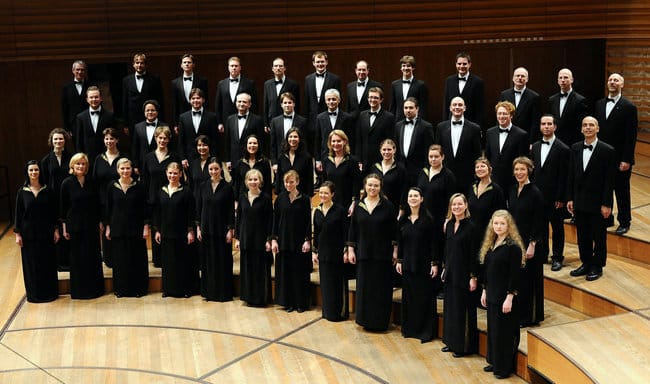
30. 9. 2020, 7 pm
Mozart Hall, Reduta Theatre
| Choirmaster: | Erwin Ortner |
Arnold Schönberg: Drei Volksliedsätze Op. 49 (selection)
Arvo Pärt: Nunc dimittis
Josef Suk: Ten Songs for Female Chorus and Piano Four Hands Op. 15
Johann Nepomuk David: Zehn Volksliedsätze (selection)
Arvo Pärt: Virgencita
Johannes Brahms: Liebeslieder Waltzer Op. 52 (65)
The concert will feature a selection of choral works mainly by 20th century authors, performed by one of the world´s most respected choral ensembles – the Arnold Schoenberg Chor.
Drei Volksliedsätze comes from Schönberg´s (1874–1951) last compositional period. The author composed the songs in 1948, in two versions: for solo voice and piano, and for mixed choir a capella. The composer made use of the modal melody of 15th and 16th century compositions.
The lyrics for the Ten Songs for Female Chorus were brought to composer Josef Suk (1874-1935) by his wife Otilie Suková, the daughter of Antonín Dvořák. It was an anthology of lyrics from Slavic folk songs and it took Suk only ten days to compose breathtaking female chorals for them in a style that is close to his incidental music for Zeyer´s play Radúz and Mahulena.
One of the most famous contemporary composers is undoubtedly the Estonian composer Arvo Pärt (1935). The Latin canticle Nunc dimittis comes from the Gospel of Luke and is one of the three hymns in the New Testament (along with the Magnificat and the Benedictus). Pärt composed the piece in Berlin in 1989, and it was first performed by the choir of St. Mary´s Cathedral in Edinburgh, led by Matthew Owens.
Virgencita for mixed choir a capella is a piece which Arvo Pärt composed as a gift for the Mexican people on the occasion of his invitation to Mexico, which was initiated by the Mexican ambassador in Estonia, Agustin Gutiérrez Canet. The premiere took place in 2012.
Although Johann Nepomuk David (1895–1977) was in direct contact with the Second Viennese School in his youth, as a composer he is considered more of a traditionalist. He was one of the 20th century’s most exceptional organists and composed many works based on modal thinking. However, he also wrote choral compositions, the most important of which is the Zehn Volksliedsätze from 1949.
Johannes Brahms (1833–1897) divided his Liebeslieder Waltzer (completed in 1869) into two opuses: Op. 52 and Op. 65 (New Love Songs). The waltzes feature a cycle of love songs in the Ländler style for voices and four-hand piano. Brahms composed to lyrics which came from a folk song collection by Georg Friedrich Daumer. The real reason why Brahms decided to use these texts for the composition is not known, but some believe that the motivation was his unfulfilled love for Clara Schumann, the wife of Robert Schumann.
Author: Jiří Zahrádka
